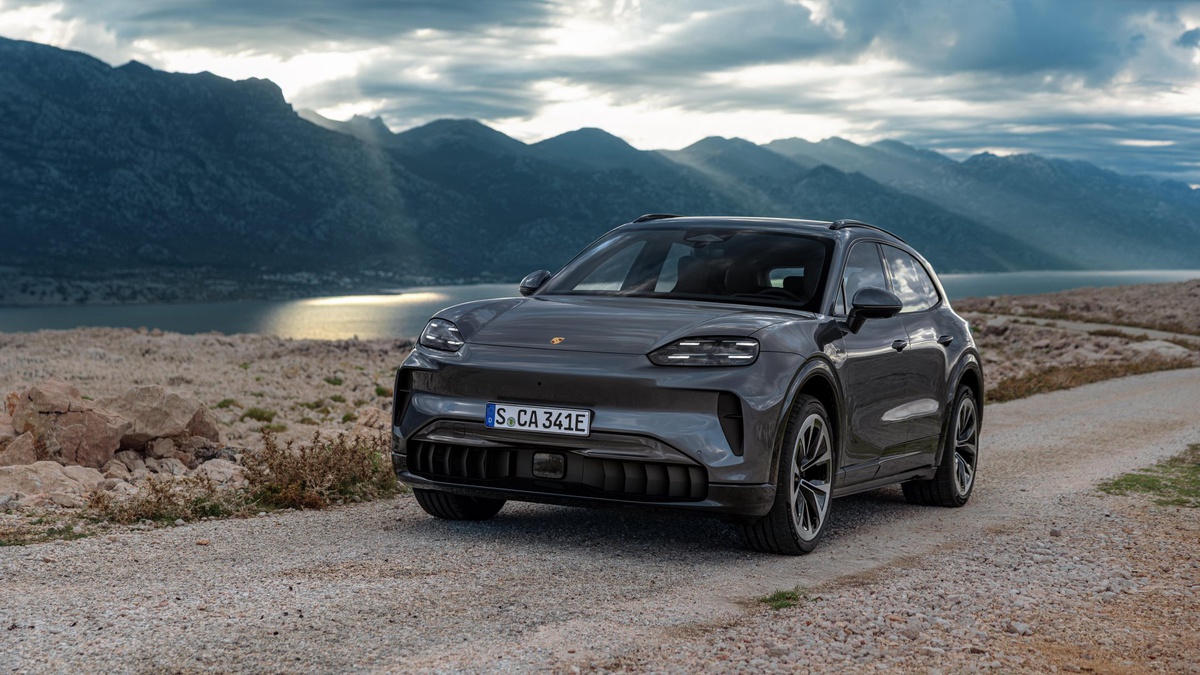The new Cayenne Electric is 55 millimeters longer than the combustion engine Cayenne (which remains available), but still not 5 meters in length. It is also 24 mm taller. However, the biggest difference is in the wheelbase, which is almost 13 cm longer than the combustion model. Length, width and height of the Cayenne Electric: 4985 x 1980 x 1674 mm. The distance between the front and rear axles is 3023 mm.
The vehicle’s design is characterized by the long hood and narrow headlights emphasizing its width. These are complemented by contoured fenders and a gently sloping roofline. The electric Cayenne is also equipped with frameless doors. The side sills are painted gray on the standard Cayenne and glossy black on the Cayenne Turbo. At the rear is a horizontal light strip and illuminated Porsche logo. An offroad package is optionally available.




Porsche Cayenne Electric
The active aerodynamic elements include movable air cooling flaps at the nose, an adaptive roof spoiler, and active aerodynamics wings at the rear of the Turbo. These extend the side splitting edges and improve flow characteristics, leading to longer range, especially at high speeds.
The interior of the Cayenne can also be personalized. There are twelve interior variants, five trim packages, and as many accent packages to choose from. New modes allow you to adjust the interior to your mood. The transparency of the panoramic glass roof can also be adjusted. The new surface heating system not only warms the seats but also contact surfaces such as armrests and door panels.
A highlight in the interior of the electric Cayenne is the Flow Display – a vertically arranged touchscreen that is inclined downward. This is complemented by a 14.25-inch instrument cluster, as well as an optional 14.9-inch passenger display and a driver head-up display. Physical buttons are provided for controlling air conditioning and audio volume. The voice control system also provides access to online information.
The rear seats are equipped as standard with electric adjustment ladies. The trunk volume varies from 781 to 1588 liters. An additional 90-liter front trunk is also available. Furthermore, the vehicle can tow trailers with a mass of up to 3.5 tons.





Porsche Cayenne Electric
The Cayenne Electric has output of up to 325 kW (442 hp), followed by the Cayenne Turbo Electric with maximum output of 850 kW (1155 hp). Both models are all-wheel drive.
The Cayenne base model develops output of 300 kW in normal mode and 325 kW with Launch Control, as well as torque of 835 Nm. Sprint from 0 to 100 km/h takes 4.8 seconds.
The Cayenne Turbo Electric develops output of up to 630 kW (856 hp) during normal driving. The push-to-pass function allows activation of an additional 130 kW for ten seconds at the touch of a button, increasing total output to 760 kW. With active Launch Control, the all-wheel drive system develops output of up to 850 kW and torque of up to 1500 Nm, allowing the vehicle to accelerate from 0 to 100 km/h in 2.5 seconds and from 0 to 200 km/h in 7.4 seconds.


Porsche Cayenne Electric
The heart of the all-electric Cayenne models is the new high-voltage battery with capacity of 113 kWh. The total range according to WLTP cycle is up to 642 km for the Cayenne Electric and up to 623 km for the Turbo. Thanks to 800-volt technology, the Cayenne charges with DC power of up to 390 kW, under certain conditions even up to 400 kW. The state of charge (SoC) can be increased from 10 to 80 percent in less than 16 minutes, and the range can be extended by up to 325 km (Cayenne) or 315 km (Cayenne Turbo) in 10 minutes.
The Cayenne Electric is also the first Porsche to optionally support inductive charging with output of up to 11 kW. To use Porsche Wireless Charging, simply park the vehicle over a ground plate. The charging process then starts automatically.
In recuperation mode, the Cayenne Electric regenerates up to 600 kW of output. In everyday conditions, this is sufficient to cover almost all braking processes; mechanical friction brakes are rarely needed. For the Cayenne Turbo, a ceramic braking system (Porsche Ceramic Composite Brake, PCCB) is also available for this purpose.
Prices start at 105,200 euros, and the Turbo costs from 165,500 euros. Orders are already being accepted.
Source: Porsche

